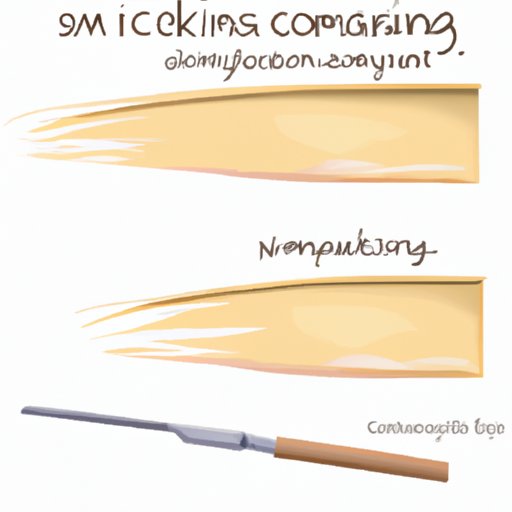
Introduction
When it comes to finishing a wall, proper preparation is key. Skim coating is the process of applying a thin layer of joint compound, also known as mud, over a wall to smooth out any imperfections and create a flawless finish. Skim coating is crucial for achieving a professional-looking wall surface, regardless of whether you plan to paint it, hang wallpaper, or create a textured wall finish. This article provides a step-by-step guide on how to skim coat a wall effectively and efficiently, so you can achieve a beautiful, smooth finish every time.
Step-by-Step Guide
Before you start skim coating a wall, make sure you have the necessary materials, including joint compound, a trowel, sandpaper, a bucket, water, and a mixer attachment for your drill. First, clean the wall thoroughly and remove any dust or debris. Next, apply a coat of primer to the wall and let it dry completely. This will help the joint compound adhere better. Here are the steps to skim coating a wall:
- Mix the joint compound with water in a bucket according to the manufacturer’s instructions. It should have a thick, creamy consistency.
- Dip the trowel into the joint compound mixture and hold it at a 45-degree angle to the wall.
- Starting at the top of the wall, apply the joint compound to the wall in a thin, even coat using long, sweeping motions. Work your way down the wall, reloading the trowel with joint compound as needed.
- Once you’ve applied the joint compound to the entire wall, go back over it with the trowel to smooth it out and remove any excess. Use long, sweeping motions to create a flat, even surface. Repeat this process until you achieve the desired level of smoothness.
- Let the joint compound dry completely, which usually takes 24-48 hours. Sand the wall lightly with sandpaper to remove any rough spots, but be careful not to sand too much and remove too much of the joint compound.
- Apply another coat of joint compound if necessary to fill in any remaining imperfections, and repeat the sanding process once it’s dry.
Remember, the key to a successful skim coating project is to apply thin, even coats and to work your way down the wall in manageable sections, maintaining a flat, smooth surface as you go.
Video Tutorial
In addition to the written guide, it’s helpful to see the skim coating process in action. Check out this video tutorial on how to skim coat a wall by This Old House: https://www.youtube.com/watch?v=IaY28Tu6WdQ
Product Review
When it comes to choosing a joint compound for your skim coating project, there are several options on the market. Here are some of the most popular products and their pros and cons:
- USG Sheetrock Joint Compound: This product is easy to mix and apply, and dries quickly. However, it may shrink and crack over time.
- DAP Fast ‘N Final Lightweight Spackling: This lightweight spackling is easy to apply and sand, and dries quickly. However, it may shrink and crack over time, and isn’t as strong as traditional joint compound.
- MiracleMud Drywall Compound: This all-natural product is easy to mix and apply, and doesn’t shrink or crack. However, it may take longer to dry than other joint compounds.
- Westpac Joint Compound: This product is easy to mix and apply, and doesn’t shrink or crack. However, it may take longer to dry than other joint compounds.
Ultimately, the product you choose will depend on your preferences, budget, and specific project needs.
Pros and Cons
Skim coating has several advantages over other methods of wall preparation, such as sanding or filling holes and cracks. For one, it creates a smooth, even surface that’s perfect for painting, wallpapering, or texturing. It’s also a good way to cover up minor imperfections in the wall without having to replace or repair the drywall itself. However, skim coating can be time-consuming and may require multiple coats to achieve a completely flat finish. Additionally, if not done properly, it can result in a lumpy or uneven surface that’s even harder to fix than the original imperfection.
Therefore, before beginning a skim coating project, it’s crucial to weigh the pros and cons and consider whether it’s the best method for your specific project needs.
Tips and Tricks
To achieve a flawless skim coat, it’s important to use the right tools and techniques. Here are some tips and tricks to help you along the way:
- Use a wide trowel to minimize the number of passes you need to make on the wall.
- Apply the joint compound in thin layers to prevent cracking and shrinking.
- Work in manageable sections to maintain a flat surface.
- Smooth out each layer of joint compound before applying another one.
- Use sandpaper to smooth out any bumps or rough spots, but be careful not to sand away too much of the joint compound.
- Keep a wet edge while working, meaning you overlap each layer slightly to prevent visible seams.
- Practice on a small section of the wall before tackling the entire project.
By following these tips and tricks, you’ll be able to achieve a smooth, flawless skim coat every time.
Conclusion
Proper wall preparation is essential for achieving a professional-looking finish. By learning how to skim coat a wall, you’ll be able to create a smooth, even surface that’s perfect for painting, wallpapering, or texturing. Use this step-by-step guide, video tutorial, product review, pros and cons, and tips and tricks to help you along the way.





